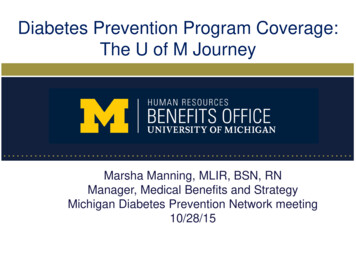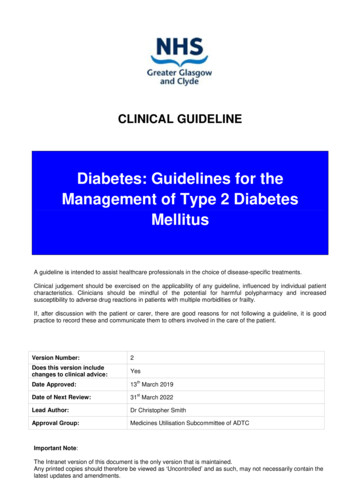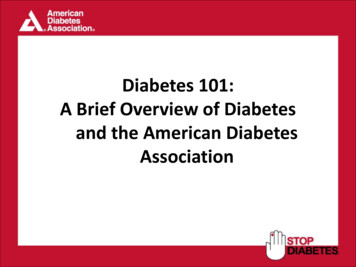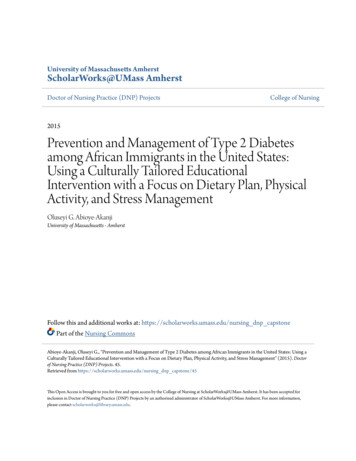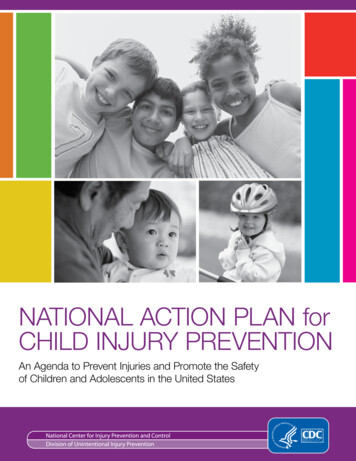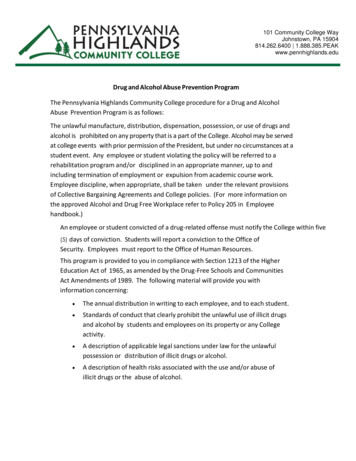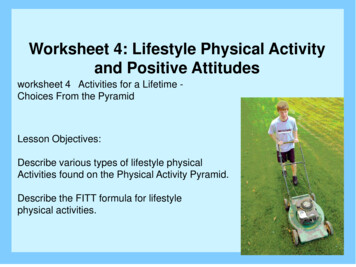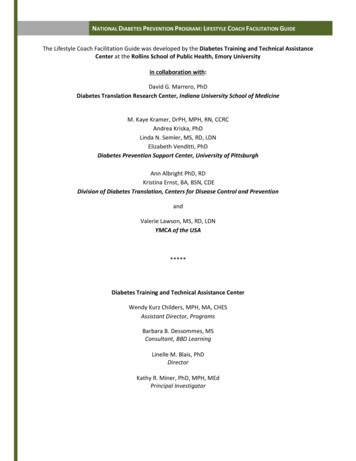
Transcription
NATIONAL DIABETES PREVENTION PROGRAM: LIFESTYLE COACH FACILITATION GUIDEThe Lifestyle Coach Facilitation Guide was developed by the Diabetes Training and Technical AssistanceCenter at the Rollins School of Public Health, Emory Universityin collaboration with:David G. Marrero, PhDDiabetes Translation Research Center, Indiana University School of MedicineM. Kaye Kramer, DrPH, MPH, RN, CCRCAndrea Kriska, PhDLinda N. Semler, MS, RD, LDNElizabeth Venditti, PhDDiabetes Prevention Support Center, University of PittsburghAnn Albright PhD, RDKristina Ernst, BA, BSN, CDEDivision of Diabetes Translation, Centers for Disease Control and PreventionandValerie Lawson, MS, RD, LDNYMCA of the USA*****Diabetes Training and Technical Assistance CenterWendy Kurz Childers, MPH, MA, CHESAssistant Director, ProgramsBarbara B. Dessommes, MSConsultant, BBD LearningLinelle M. Blais, PhDDirectorKathy R. Miner, PhD, MPH, MEdPrincipal Investigator
The CDC Diabetes Prevention Program curriculum (CDC DPP curriculum) is based on the curriculum fromthe Diabetes Prevention Program (DPP) research study1 supported by the National Institutes of Health,National Institute of Diabetes and Digestive and Kidney Disease.CreditsUse of the CDC DPP Curriculum must be properly attributed and credited with the following copyrightcredit line: 2012, University of Pittsburgh, based on the DPP research trial supported by cooperativeagreement number U01-DK48489 from the U.S. Department of Health and Human Services, which hascertain rights in the material.Terms and Conditions of UseWith proper attribution and credit, the CDC DPP curriculum may be used as follows without furtherpermission or license from the University of Pittsburgh:a. Non-profit research and non-commercial education purposes;b. Charging a fee solely for cost recovery of materials and operations related to delivery of thecurriculum;c. Use of the curriculum for the purpose of third-party reimbursement so long as no profit is madeon this specific effort by the party delivering the lifestyle change intervention or administeringthese curricula as it is described above, for third-party reimbursement.Conditions in which usage of the CDC DPP curriculum requires obtaining written permission and/orlicense from the University of Pittsburgh:a.b.For-profit research or for-profit education activities; andSale or use of the CDC DPP curriculum for any commercial purpose other than as describedabove.Use of the CDC DPP curriculum for commercial purposes, other than as described above, is prohibitedwithout the further written permission and/or license of the University of Pittsburgh. For furtherinformation on commercial use of the CDC DPP curriculum, contact the University of Pittsburgh's Officeof Technology Management at 412-648-2206.Knowler WC, Barrett-Connor E, Fowler SE, Hamman RF, Lachin JM, et al. 2002. N Engl J Med 346: 393403.1
HOW TO USE THE LIFESTYLE COACHFACILITATION GUIDEAlthough the content differs from session to session, many common threads runthrough each session of the core curriculum. This section shows Lifestyle Coaches howto prepare for sessions and how to use the Facilitation Guide.Preparation ChecklistThe “Preparation Checklist” contains several lists: materials needed for each session,tasks to do before each session, tasks to do after participants arrive, and tasks to do afterthe session ends.Materials needed for each session: Participant handouts for the relevant session.Food and Activity Trackers (one per participant).o Blank trackers for the week following the session.o Reviewed trackers from the previous session to return to participants.Balance-beam (preferred) or digital scale.Lifestyle Coach’s LogBlackboard, whiteboard, or flip chart and the appropriate writing utensils.For some sessions, the following are also needed: Food models to demonstrate portion size and fat content.Empty food packages showing nutrition information.Measuring cups and spoons.Restaurant menus.Tasks to be done before each session: Choose a private place to weigh participants.Have your Lifestyle Coach’s Log ready for weigh-ins.Set up the room as described on page 8.Have name tents or tags prepared before Session 1.
Tasks to be done as participants arrive: Weigh each participant privately.Give each participant a set of handouts to insert into the Participant Notebook.Have participants record their weight and physical activity on the “How Am IDoing?” charts in their Participant Notebooks.Distribute “Food and Activity Trackers” for the coming week.Except when noted, collect the previous week’s “Food and Activity Tracker”from each participant (some sessions call for the participants to refer to theirtracker during the session).Return to participants the “Food and Activity Trackers” (with notes from theLifestyle Coach) that were collected at the last session.Tasks to be done after each session: Write notes about the session on the “Notes and Homework” page at the end ofthe guide for each session.Review each participant’s “Food and Activity Tracker.” Comment on successesand, when necessary, recommend changes.Lifestyle Coach BriefThe Lifestyle Coach Facilitation Guide also provides a “Lifestyle Coach Brief,” whichincludes learning objectives for the session, an overview of the session, and a briefdescription of each part of the session.Learning ObjectivesThese objectives tell the Lifestyle Coach what the participants should be able to do ordiscuss by the end of the session.Session OverviewThe session overview is a brief summary of the topics to be covered during the sessionand the amount of time allotted for each topic.
Session PartsAll sessions are in several parts. For most sessions (except Session 1, which has mostlyintroductory material), the sessions are structured as follows:Part 1: Weekly Progress and Review (10 minutes):This section is the same for each session. Participants are weighed privately andthen asked to take their seats in the room. The Lifestyle Coach leads a briefreview of the information covered during the previous session and thendiscusses participants’ successes, challenges, and questions since the group lastmet.The Lifestyle Coach also follows up on the previous week’s “To Do Next Week”list by asking questions such as “were you able to follow your action plan for lastweek?” “What did you learn by following the plan?”Parts 2 and 3 (40–50 minutes)The Lifestyle Coach explains the session content, leads discussions on the topic,asks questions to probe the participants’ thoughts, beliefs, and feelings about thetopic and how they will put what they learn into practice. The time allotted foreach topic depends on its complexity and the number of activities to be doneduring the session.Part 4: Wrap Up and To-Do List (10 minutes)This final part is the same for most sessions. The Lifestyle Coach summarizeswhat was covered during the session and explains the tasks assigned forparticipants to accomplish before the next session.The tasks assigned to participants are written on a “To Do Next Week” handout.Participants do these tasks between sessions. The tasks call on participants toapply the lessons learned during the session, to practice using the tools given tothem during the session, and to test their own ideas and solutions to challengingsituations related to food or activity that occur between sessions.Key MessagesBefore closing each session, the Lifestyle Coach summarizes the key messages from thesession. These messages should be reinforced periodically throughout the program.
Session PresentationAlso provided are step-by-step talking points for each session: these points include thenew material to present to the participants, topics to discuss, questions to ask, activitiesto conduct, and suggestions to offer.Lifestyle Coaches should not simply read the text as written. Rather, they should usethe text to prepare for each session and to ensure that all important points arediscussed, that all participants’ questions are answered satisfactorily, and thatparticipants have a chance to practice the recommended strategies for overcomingchallenges. Lifestyle Coaches should follow the sequence of activities in the guide (i.e.,cover all the material in the order it is presented in the guide). At the same time,Lifestyle Coaches should assess the participants’ backgrounds and interests and tailortheir language, examples, questions, suggestions, and recommendations accordingly.Notes on FormatNew material to be presented to participants is introduced with “Present”: forexample,Present: Today we are going to talk about physical activity and its importanceto a healthy lifestyle.Discussion questions are introduced with “Ask”: for example,Ask: Were you able to make the active lifestyle choices you planned?Discussion questions are followed by “Open Responses,” which indicatesthat the Lifestyle Coach wants to hear whatever participants have to say on thequestion.
IconsNotice that a different icon represents each directive.Participant handouts are introduced with ”Refer”: for example,Refer participants to the “What Makes You Eat?” handout in theParticipant Notebook.Participant activities are introduced by “Activity”: for example,ActivityThink of one problem food cue that you will get rid of before next week and howyou will do so.Write down the problem and what you will do to get rid of it.Some activities require looking at participant handouts; some are group-based; andothers require individual attention.Notes to Lifestyle CoachThroughout the guide are notes to the Lifestyle Coach. These are asides from the text tobe presented to the participants. They provide information that the Lifestyle Coachshould know but that participants do not need to know. Sometimes they suggest how tohandle certain participants or situations.These notes are in separate green boxes with this icon.
Notes and HomeworkAs soon as possible after each session, the Lifestyle Coach should use the “Notes andHomework” page to write notes about the session. The notes should include commentson what worked, what needs to be done differently for the next session, whichparticipants need follow-up, what information or ideas the Lifestyle Coach needs toresearch, and general concerns or issues that need to be addressed.Below are examples of the type of notes the Lifestyle Coach should make: Research local walking trails and maps to provide to participants next session. The discussion on likes and dislikes of physical activity turned out very negative.We need a more effective way to lead into the discussion on physical activity. Infuture sessions, it may make sense to focus first on the positive, or use the groupdiscussion to troubleshoot a few of the negative associations. Carla will not be able to attend the session after next. Bring an extra “Food andActivity Tracker" for her next session.Setting up the RoomThe ideal room setup for sessions is tables or desks in a circle or semi-circle. Participantsshould be able to see and engage each other and the Lifestyle Coach, so rows or longnarrow tables are generally not well suited. The Lifestyle Coach may stand or sit duringthe session, depending on preference.The Lifestyle Coach should always be the first to arrive in order to arrange the seating,get materials and supplies ready, put up the flip chart or white board, and make sure allequipment (especially the scale) is present and working properly. Another reason forLifestyle Coaches to arrive first is so they can greet participants as they arrive. Byarriving early, Lifestyle Coaches can break the ice, introduce participants to each other,and begin to build relationships. Relationship building is especially important duringthe early sessions of the program.
Keeping on ScheduleKeeping to the time allotted for each part of the session is especially important to ensurethat all the material is covered within 1 hour. Without arriving early to prepare andorganize, Lifestyle Coaches cannot cover everything within 1 hour. Being early,prepared, and organized helps to build a positive rapport with participants, modelsaccountability for the participants, and demonstrates respect or other people’s time.Keeping on schedule also minimizes the burden on participants who need to keep onschedule because of child care or other activities.Not only should Lifestyle Coaches arrive early, they should ask participants to do thesame so weigh-ins can be completed before the 1 hour for the session begins. Ifparticipants arrive late, the Lifestyle Coach may ask them to stay after the session fortheir weigh-in.Stay on time!Data CollectionLifestyle Coaches record each participant’s weight at every session. These weeklyweights also serve as an attendance record for participants. After physical activity isintroduced during Session 5, Lifestyle Coaches should also record the number ofminutes of physical activity each participant completed during the previous week. Alldata should be recorded on the Lifestyle Coach’s Log and submitted to the Centers forDisease Control (CDC) per recognition requirements.Make-Up SessionsIf a participant is unable to attend a session, the Lifestyle Coach should schedule a timeoutside of class to make up the session one-on-one (or in a small group if severalparticipants did not attend a session). As usual, each participant’s weight should berecorded and the handouts provided. The Lifestyle Coach and participant shoulddiscuss the material that was covered in the missed session. It may not be necessary toallocate an entire hour for the make-up session; often a 15–30 minute meeting issufficient, which for convenience may be held before or after the following session.
Guidelines for Tailoring Sessions to the GroupWhen preparing for and presenting the session material, the Lifestyle Coach shouldtailor certain elements to the group’s background, learning style, and interests. This willprimarily involve incorporating examples that are relevant to a participant’s ethnicity,financial means, and preferences.The Lifestyle Coach should feel free to replace any of the examples given on theparticipant worksheets with other, more relevant examples. If group members do notgenerally eat foods such as potato chips or bologna, the Lifestyle Coach can usedifferent foods suggested by participants. Similarly, the Lifestyle Coach may usesupplementary educational aids if such materials can be used in a way that willenhance learning and not draw attention or time away from the curriculum. Keep inmind that a great deal of information is being presented during the 16 core sessions, sodo not overwhelm participants with additional information and handouts. Even moreimportantly, too much information may eclipse the key concepts of the lifestyle changeprogram. Below are some examples of appropriate ways to tailor or add supplementarymaterials to a session: Use food models or examples that are in line with the culture and preferences ofthe group. Provide walking maps of the areas where participants live. Organize a recipe-swap to which participants bring copies of their favorite lowfat recipe to share with others.The examples above support the content of the lifestyle change program, do not needexcessive time, and may increase the relevance and interest for participants.Below are examples of what not to do. They would take time away from the many basicconcepts to be presented and may not be relevant for all participants. Do not have a hypnotist come to a session on motivation. Do not decide against holding a session on the basis that participants do notseem to need it. Do not have a cooking demonstration on low-fat vegetarian cooking.
Lifestyle Coach’s Log HOW TO USE THE LIFESTYLE COACH FACILITATION GUIDE Although the content differs from session to session, many common
